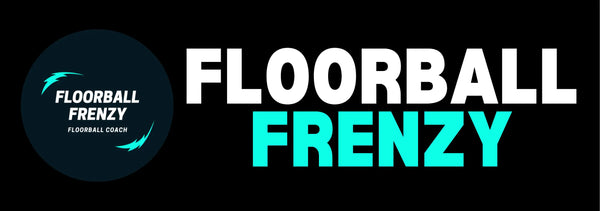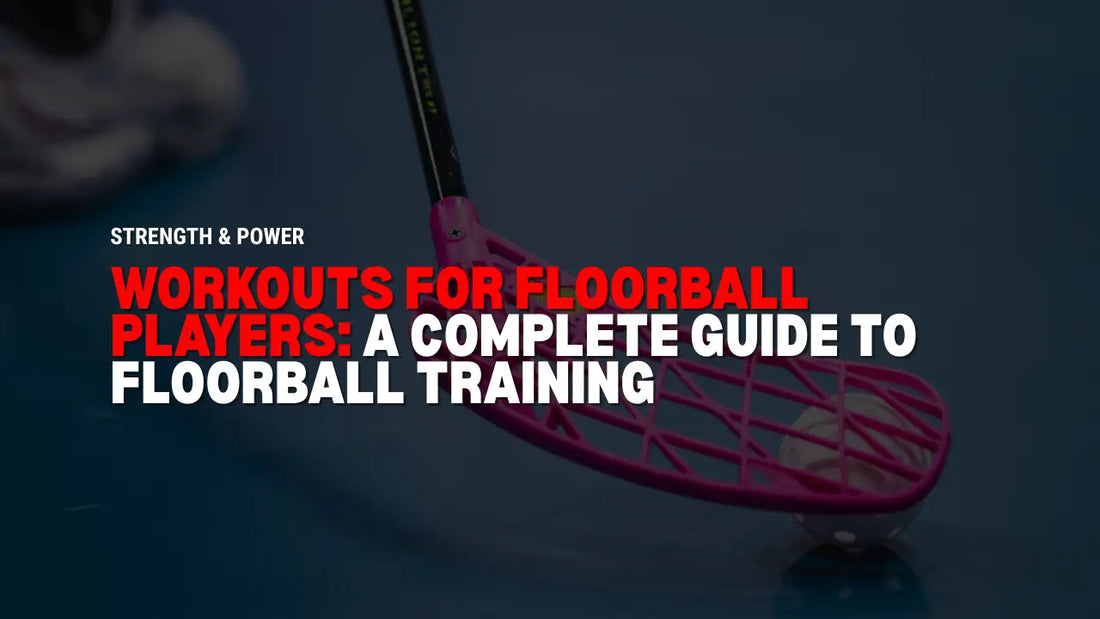Workouts for Floorball Players: A Complete Guide to Floorball Training
As floorball continues to get faster and more dynamic, the physical demands on players have never been higher.
Much like the evolution of the game on the court, there’s been an evolution of training off it. Gone are the days of “body part” focused workouts, half-assed strength sessions, or going for the occasional jog.
Today’s elite players are training in a completely different way. They’re using integrative workouts to train kinetic chains, refining their movement quality, getting strong and powerful while staying lean, mobile, and quick.
The game demands it.
At FloorballFrenzy, this is what we specialize in – strength & conditioning that translates to the court. In this article, we’re going behind the scenes to explore exactly how floorball players should be training to thrive in the modern game. The same formula used by pros, and the process we know delivers results.
If you want to learn what workouts elite floorball players do, this is your article.
Let’s dive in.
The Perfect Training Split for Floorball Players
Let’s start by defining how often floorball players should be training.
We’re often asked: “What’s the perfect split or training schedule for floorball players?”
Traditional training splits (upper/lower, push/pull, or body part days like “chest day”) might work for bodybuilders, but for athletes like floorball players, it’s outdated and limits performance.
All of our floorball workout programs use a full-body approach. This is because we want to train the integrative chains that directly translate to movement on the court — sprinting, stopping, stick battles, and shooting.
This approach allows us to challenge all major movement patterns each session, while still giving emphasis to certain ones on specific days.
For example:
- Day 1: Squat + Push (Goblet Squat + Landmine Press)
- Day 2: Lunge + Pull (Reverse Lunge + Pull-ups)
- Day 3: Hinge + Push (Trap Bar Deadlift + Incline Chest Press)
Even if one pattern is the focus, the rest are still being trained in supporting exercises.
Summary: Floorball players should train full-body splits that cover all key movement patterns every workout.
How often should floorball players workout?
This depends on training priorities, time of year, and experience.
Some high-level coaches program 4 lifts per week (Mon/Tues, Thurs/Fri) — but for most floorball players, 3 focused strength workouts per week produces better results.
This schedule leaves room for speed sessions, mobility work, and skill training, while also allowing the nervous system to fully recover.
The ideal floorball training week might look like this:
- Monday: Strength (60–75 min)
- Tuesday: Speed (30 min) + Mobility (20 min)
- Wednesday: Strength (60–75 min)
- Thursday: Speed (30 min) + Mobility (20–30 min)
- Friday: Strength (60–75 min)
- Saturday: Conditioning or extra speed/mobility (30–45 min)
- Sunday: Rest
This split allows plenty of recovery while still stacking strength, speed, and conditioning. In-season, the same principle applies — most pro floorball players still do 2–3 strength sessions per week.
Ultimately, your schedule should fit your lifestyle and priorities. Some players need more skill sessions, others need more strength or speed — know your goals and build around them.
The Structure of a Floorball Workout
Floorball workouts are not about bodybuilding. They’re about developing movement systems that transfer to the game.
Every floorball workout should be built around this structure:
- Dynamic Warm-Up
- Prehab & Mobility
- Athleticism (speed & agility work)
- Strength & Power Blocks
- Finisher: Core/Conditioning/Mobility
- Cool Down
This is the same framework you’ll find in elite floorball training programs.
Prehab & Mobility
Prehab (injury-prevention exercises) is non-negotiable for floorball players. Long games, low stances, and quick turns put repetitive stress on the hips, knees, and back.
These exercises activate stabilizers, mobilize tight areas, and correct imbalances before they become injuries. Think hip openers, band work, and dynamic core activation.
Athleticism & Speed Training
Speed is everything in floorball. First steps, quick turns, and reactive agility win battles.
This block focuses on one theme per workout, such as:
- Acceleration (linear or lateral)
- Deceleration & landing mechanics
- Multi-directional speed (shuffling, pivoting)
- Agility & reaction drills
- Positional/postural mechanics (planting, absorbing, redirecting)
We usually program 3–5 drills per session, repeated with full recovery. Speed isn’t conditioning — you need to be fresh.
Strength Training for Floorball Players
This is the backbone of training.
A floorball workout typically includes 2–3 blocks of 3–4 exercises done in supersets.
The goal is intensity and movement quality, not rushing.
Every workout should include all five movement patterns:
- Squat
- Hinge
- Lunge
- Upper Body Push
- Upper Body Pull
Training these consistently ensures balanced development and strength that carries directly onto the floorball court.
The Finisher: Core, Conditioning, or Mobility
The final block of the workout should have a clear purpose.
- Conditioning: HIIT-style intervals, short and explosive.
- Core: Focused anti-rotation, anti-extension, and bracing drills.
- Mobility: Active stretches and long holds to restore range.
This is where many players just “go through the motions.” Instead, finish with intensity and intention.
Example Floorball Workout
Here’s a sample full-body session:
Pre-Hab Series (2x):
Standing Opening the Gate [8 each]
Overhead Squat with Band [12 reps]
X-Band Walks [12 each]
Runners Lunge with Rotational Reach [8 each]
Athleticism (2x):
5 Yard Shuffle [20 sec]
Lateral Hurdle Bounds [12 reps]
Diagonal Skater Bounds w/ 2s Pause [10 reps]
Block A (3–4x):
Goblet Squat [10 reps]
Alternating Lunge Jump [12 reps]
Alternating Dumbbell Chest Press [12 reps]
Adductor Side Plank [20 sec]
Block B (3–4x):
Kettlebell Swing [12 reps]
Half-Kneeling Lat Pull Down [8 each]
Palloff Press [10 each]
Bear Crawl [20 reps]
Extra Core (2–4x):
Slider Plank [10 reps]
Side Plank [30+ sec]
Plank [60+ sec]
Extra Mobility (1–2x):
Couch Stretch [8 each]
90/90 Hip Flow [5 each]
Scorpions [14 reps]
Extra Workouts
In addition to 3 full-body sessions per week, floorball players should include extra sessions based on their needs:
Speed Workouts: Focused on acceleration, agility, and multi-directional quickness.
Conditioning Workouts: High-intensity interval training (not long slow cardio).
Mobility Workouts: Dedicated sessions to improve flexibility, restore balance, and reduce risk of injury.
Common Floorball Training Questions
How often should floorball players work out?
3–5 times per week. Usually 3 strength sessions, 2 speed sessions, and 1–2 mobility/conditioning sessions depending on the season.
What muscles are most important for floorball?
The glutes and posterior chain (glutes, hamstrings, calves) for sprinting and stability. But ultimately, all muscle groups are essential — this is why we train movement patterns, not just muscles.
Are squats good for floorball?
Absolutely. Goblet Squats, Front Squats, Split Squats, and single-leg variations are key. Pair them with hinge (deadlifts), lunge, and rotational exercises for best results.
What’s the best floorball workout program?
One that combines strength, speed, conditioning, and mobility in an integrative approach. No random exercises. No bodybuilding fluff. Just training that makes you a better athlete on the floorball court.
🔥 If you’re serious about becoming faster, stronger, and more resilient, then it’s time to train the way the best floorball players do — with structure, intensity, and intention.
Ready to make it even easier?
When you grab any product from FloorballFrenzy.com, you’ll also receive:
- BONUS: Mobility & Stretching Guide for Floorball – daily routines that fit seamlessly into your workouts.
- BONUS #2: Travel Workouts for Floorball Players – perfect for keeping your strength and speed sharp anywhere.
- BONUS #3: Game-Day Nutrition Blueprint – so all that training actually shows up when it matters most.
These bonuses were designed to back up exactly what this article teaches — turning “what to do” into real-world results on the court.

